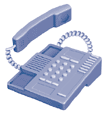 
|
|

Telecommunications: Phones and More
Fact sheet #2 looks at the widening telecommunications
field and its impact on the everyday lives of older adults.
The communications field has grown far beyond the telephone to include
fax machines, e-mail (electronic mail), monitoring devices and
other teleservices. The development of voice, fax, video, data and other
digital transmission technology has changed how and when we communicate
but not why. Communicating with friends, family, health care providers
and the community is as important as it always was. Seniors are benefiting
from new communication technologies that allow them to stay in touch with
loved ones both near and far.
Everyday Telephone Innovations
New telephone technologies can provide increased independence, convenience
and safety. A wide variety of services and equipment is available from
telephone companies. Be aware that most of them add extra charges to your
monthly telephone bill.

- Portable Cordless Phones prevent rushing to answer a phone
in another room. Cellular phones (wireless telephones) are portable
and operate on batteries. They make it easy to send and receive important
telephone calls when you are away from your home and can be helpful
in case of an emergency.
- Voice Mail Systems/Answering Machines take messages from callers
when you are not able to answer your phone. Your telephone company may
offer an automated answering service for a monthly fee or you can purchase
an answering machine to plug into your phone. When setting up a recorded
message, don't tell callers you are not home, or let them know that
you live alone. Simply say "you have reached (your number) and
we can't take your call at the moment." Some seniors have a family
member or friend who has a clear, firm voice record the greeting.
- Caller Identification, Call Waiting, Call Blocking, Call Tracing
services are just a few of the features most telephone companies provide
for a fee. Look through your telephone directory or call your telephone
service to ask for a full explanation of these services.
- TTY (teletypewriter), also known as TDD (telecommunications
device for the deaf), are services that make it possible for customers
with a hearing impairment to use the telephone. Relay is the
service provided by telephone companies to enable TTY users and non-TTY
users to communicate. Customers communicate by typing into the TTY.
An operator interprets the message and communicates it to the person
they are contacting.
Automated Voice Response Systems (AVRs) are answering systems
used by many companies that ask you to press a number on the phone key
pad that corresponds to your inquiry from a list of choices. Its purpose
is to direct calls to the most appropriate person and/or answer common
questions. AVRs are cost effective for companies, as they require fewer
service representatives. Many people find these systems frustrating if
the menu choices do not match their inquiry and/or they would rather speak
to a person. But if the system is well designed, it may be convenient
and save time.
A well designed AVR system should include:
- Simple clear choices

- An option to speak to a person
- An option to repeat the menu
If you encounter a poorly designed AVR system, tell the company.
AVR systems should serve, not frustrate, customers.
AVR Tips
-
Make your call when you have a block of time and will not be interrupted.
-
Listen to all of the choices first, writing down any that seem to
fit your inquiry.
-
Even if ‘0' is not offered as an option to speak to a person
directly, try pressing it anyway.
-
If the menu choices seem unnecessarily complicated or too long, let
the company know. Menus are sometimes poorly designed and the choices
not clearly explained.
-
Be patient with yourself and just hang up if you become confused.
The machine does not care how many times you hang up or call back!
Telephone Tips
-
Have a pencil and paper handy when you make any call but especially one that you know will be answered by an AVR (see above). Beforehand, write down your main points so that if you have to wait until your call can be answered, you won't forget them.
A word of caution: some cell or portable phones may not be secure; their signal could be picked up by other electronic devices in the area, such as baby monitors or private scanners; so do not use them for confidential calls. |
Portable cordless phones have become relatively inexpensive. Be sure to read thoroughly the instructions that come with your phone. A welcome feature with most phones is the locator button on the telephone base. When pressed, the handset will emit a series of beeps to let you know where you last used it.
-
Talking on a cell phone while driving has been shown to be a major distraction for drivers — in fact, in some jurisdictions, it is against the law. Exercise some common sense.
Sources:
Coughlin, Joseph F. Technology Needs of Aging Boomers. Issues
in Science and Technology Online. Fall 1999.
Listening to Canadians. Communications Survey, Fall 2000.
White, Jo and Ann Weatherall. A Grounded Theory Analysis of Older
Adults and Information Technology. Educational Gerontology, 26:371-
386, 2000.
Techno Terms
- AVR
- An Automated Voice Response System is an electronic telephone
answering service used by many companies to direct your call to the
appropriate person or department and increasingly, by medical and professional
offices to book appointments. Most use a ‘menu' style, in which
you make your choices by pressing the buttons on your phone. This system
does not work with a rotary telephone.
- Cellular Phone
- A wireless telephone.
- Fax Machine
- Sends and receives printed pages or images over telephone lines by
converting the printed material to and from electronic signals.
- Pound Key
- The number sign (#) often used in automated voice response systems
(AVRs) to designate a choice in the list of options.
- Star Key
- (*) Often used in automated voice response systems to exit a system.
- TTY (teletypewriter)/TDD
(telecommunications device for the deaf)
- Are services that make it possible for customers with a hearing impairment
to use the telephone. Relay is the service provided by telephone companies
to enable TTY users and non-TTY users to communicate. Customers communicate
by typing into the TTY. An operator interprets the message and communicates
it to the person they are contacting.
[Previous] [Table of Contents] [Next]
|




